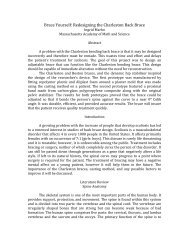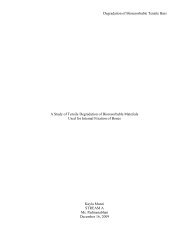Got Food? - the Scientia Review
Got Food? - the Scientia Review
Got Food? - the Scientia Review
You also want an ePaper? Increase the reach of your titles
YUMPU automatically turns print PDFs into web optimized ePapers that Google loves.
With <strong>the</strong>se new developments in preservatives, people that choose organic foods over foods with<br />
artificial preservatives will be able to use this natural chemical to enhance <strong>the</strong> shelf life of organic food<br />
ra<strong>the</strong>r than using manmade chemicals. The amount of a given preservative that can be added to a product<br />
is limited by part 172 of <strong>the</strong> Code of Federal Regulations. Some examples of food preservatives with<br />
restrictions include Anoxomer, BHA, BHT, dehydroacetic acid, and calcium didsodium EDTA.<br />
Spices in Preservation<br />
Preservatives are characterized as food additives because <strong>the</strong>y are added to food and act to resist<br />
spoilage. Under <strong>the</strong> category of additives, preservatives can be divided into two major categories.<br />
Antioxidants prevent fruit from spoiling and prevent oils and fats from turning rancid, and antimicrobial<br />
agents impede <strong>the</strong> development of bacteria and mold (―<strong>Food</strong> additives‖, 2011). Spices can be both<br />
antioxidants and antimicrobial agents because <strong>the</strong>y can act to prevent <strong>the</strong> spread of bacteria and also<br />
prevent, or prolong, <strong>the</strong> spoilage of fruits and fats.<br />
Spices can come from shrubs, vines, lichens, seeds, flowers, roots, vines, and <strong>the</strong> fruits of<br />
herbaceous plants. The spices derive from compounds known as phytochemicals and cause <strong>the</strong> aroma and<br />
flavor of spice. In nature, <strong>the</strong> spices know evolved as defenses of plants against predatory animals and<br />
insects. A recent study on spices entitled ―Darwinian Gastronomy‖ attempted to quantify <strong>the</strong> amount of<br />
spice in region of <strong>the</strong> world. In one test, <strong>the</strong>y concluded that India had <strong>the</strong> most spices used in a meatbased<br />
dish out of a sample size of 36 countries. While <strong>the</strong> amount of spices per recipe was informative,<br />
<strong>the</strong> o<strong>the</strong>r research enacted in this study proved to reveal <strong>the</strong> preservative qualities of spices.<br />
Of <strong>the</strong> 30 tested spices, all of <strong>the</strong> spices were able to kill 25% of <strong>the</strong> bacteria for which <strong>the</strong>y had<br />
been tested. Not only did each spice have antimicrobial behavior, 50% of <strong>the</strong> 30 spices tested were able<br />
to prevent 75% of bacterial growth. The most efficient spices were garlic, onion, allspice, and oregano.<br />
The regions of <strong>the</strong> world nearest to <strong>the</strong> equator of Earth have a higher spice usage seemingly because food<br />
spoilage rates are higher in areas of a higher climate. When a spice is cooked, <strong>the</strong> phytochemicals are not<br />
affected and retain <strong>the</strong> aroma and flavor. Spices are not <strong>the</strong> only factor in antimicrobial behavior because<br />
<strong>the</strong>re are o<strong>the</strong>r chemicals called synergist: lemon juice, peppers, and o<strong>the</strong>r similar citric acids act as<br />
disruptors to <strong>the</strong> membranes of bacterial cells. The low pH attributed to synergists allows spices to more<br />
actively kill and prevent bacterial growth and bacteria.<br />
A spice shop where people are able to purchase<br />
multiple preservatives.<br />
111
















